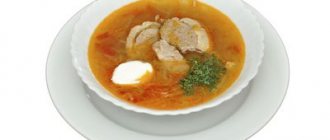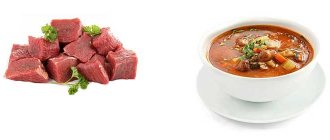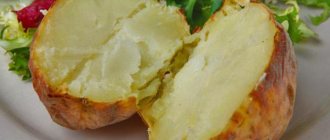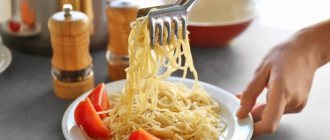How many calories:
=78 kcal.
There are 78 calories in Chicken Noodle Soup with Broth. per 100 grams.
You can use different parts of chicken for chicken noodles. If you use only skinless breasts, you can reduce the fat content of the broth, while the calorie content of the dish will decrease by 15 kcal per 100 grams. The noodles can be homemade or any purchased noodles (horns, spider webs, stars), the calorie content of the soup will not change significantly. 100 grams of the product “Chicken noodle soup in broth” contains:
- Water - 54 g;
- Chicken - 22 g;
- Potatoes - 11 g;
- Carrots - 5 g;
- Dry pasta - 5 g;
- Onion - 3 g;
Composition of nutrients, BJU
Chicken noodle soup with broth
| For quantity: 100 grams | ||
| Calories — 78 | Calories from fat - 25 | |
| BJU | ||
| Total fat content | 2.78g | |
| Saturated | 0.75g | |
| Polyunsaturated | 0.61g | |
| Monounsaturated | 1.08g | |
| Cholesterol | 21mg | |
| Total carbohydrate content | 6.6g | |
| Dietary fiber | 0.66g | |
| Sugar | 0.45g | |
| Squirrels | 6.37g | |
| Vitamins and microelements | ||
| A - 54.98 µg | C - 8.7 mg | |
| B-6 – 0.13 mg | B-12 – 0.14µg | |
| D - 0.02 µg | E - 0.11 mg | |
| Calcium 12mkg | Iron 0.62mg | |
| Magnesium 11.67 mg | Zinc 0.54 mg | |
| Potassium 131 mg | Sodium 39 mg | |
Distribution of calories for BJU:Carbohydrates (36%) Fats (32%) Proteins (32%) | ||
Calories in Chicken Noodle Soup. Chemical composition and nutritional value.
Nutritional value and chemical composition of Chicken Noodle Soup.
The table shows the nutritional content (calories, proteins, fats, carbohydrates, vitamins and minerals) per 100 grams of edible portion.
| Nutrient | Quantity | Norm** | % of the norm in 100 g | % of the norm in 100 kcal | 100% normal |
| Calorie content | 85 kcal | 1684 kcal | 5% | 5.9% | 1981 |
| Squirrels | 4.2 g | 76 g | 5.5% | 6.5% | 1810 |
| Fats | 4 g | 56 g | 7.1% | 8.4% | 1400 g |
| Carbohydrates | 8.2 g | 219 g | 3.7% | 4.4% | 2671 g |
| Organic acids | 17.2 g | ~ | |||
| Alimentary fiber | 0.6 g | 20 g | 3% | 3.5% | 3333 g |
| Water | 84.5 g | 2273 g | 3.7% | 4.4% | 2690 g |
| Ash | 0.3 g | ~ | |||
| Vitamins | |||||
| Vitamin A, RE | 200 mcg | 900 mcg | 22.2% | 26.1% | 450 g |
| Retinol | 0.2 mg | ~ | |||
| Vitamin B1, thiamine | 0.02 mg | 1.5 mg | 1.3% | 1.5% | 7500 g |
| Vitamin B2, riboflavin | 0.03 mg | 1.8 mg | 1.7% | 2% | 6000 g |
| Vitamin B4, choline | 13.6 mg | 500 mg | 2.7% | 3.2% | 3676 g |
| Vitamin B5, pantothenic | 0.1 mg | 5 mg | 2% | 2.4% | 5000 g |
| Vitamin B6, pyridoxine | 0.1 mg | 2 mg | 5% | 5.9% | 2000 g |
| Vitamin B9, folates | 3.7 mcg | 400 mcg | 0.9% | 1.1% | 10811 g |
| Vitamin B12, cobalamin | 0.08 mcg | 3 mcg | 2.7% | 3.2% | 3750 g |
| Vitamin C, ascorbic acid | 2.8 mg | 90 mg | 3.1% | 3.6% | 3214 g |
| Vitamin E, alpha tocopherol, TE | 0.2 mg | 15 mg | 1.3% | 1.5% | 7500 g |
| Vitamin H, biotin | 1.6 mcg | 50 mcg | 3.2% | 3.8% | 3125 g |
| Vitamin RR, NE | 1.547 mg | 20 mg | 7.7% | 9.1% | 1293 g |
| Niacin | 0.8 mg | ~ | |||
| Macronutrients | |||||
| Potassium, K | 55.6 mg | 2500 mg | 2.2% | 2.6% | 4496 g |
| Calcium, Ca | 11.6 mg | 1000 mg | 1.2% | 1.4% | 8621 g |
| Silicon, Si | 0.2 mg | 30 mg | 0.7% | 0.8% | 15000 g |
| Magnesium, Mg | 8.1 mg | 400 mg | 2% | 2.4% | 4938 g |
| Sodium, Na | 18.5 mg | 1300 mg | 1.4% | 1.6% | 7027 g |
| Sera, S | 36.2 mg | 1000 mg | 3.6% | 4.2% | 2762 g |
| Phosphorus, P | 46.2 mg | 800 mg | 5.8% | 6.8% | 1732 g |
| Chlorine, Cl | 283.3 mg | 2300 mg | 12.3% | 14.5% | 812 g |
| Microelements | |||||
| Aluminium, Al | 17.6 mcg | ~ | |||
| Bor, B | 7.9 mcg | ~ | |||
| Vanadium, V | 1.9 mcg | ~ | |||
| Iron, Fe | 0.7 mg | 18 mg | 3.9% | 4.6% | 2571 g |
| Yod, I | 1.2 mcg | 150 mcg | 0.8% | 0.9% | 12500 g |
| Cobalt, Co | 2.3 mcg | 10 mcg | 23% | 27.1% | 435 g |
| Lithium, Li | 0.1 mcg | ~ | |||
| Manganese, Mn | 0.039 mg | 2 mg | 2% | 2.4% | 5128 g |
| Copper, Cu | 47.8 mcg | 1000 mcg | 4.8% | 5.6% | 2092 g |
| Molybdenum, Mo | 1.6 mcg | 70 mcg | 2.3% | 2.7% | 4375 g |
| Nickel, Ni | 0.2 mcg | ~ | |||
| Rubidium, Rb | 9.7 mcg | ~ | |||
| Fluorine, F | 24.2 mcg | 4000 mcg | 0.6% | 0.7% | 16529 g |
| Chromium, Cr | 1.7 mcg | 50 mcg | 3.4% | 4% | 2941 g |
| Zinc, Zn | 0.4005 mg | 12 mg | 3.3% | 3.9% | 2996 g |
| Digestible carbohydrates | |||||
| Starch and dextrins | 0.07 g | ~ | |||
| Mono- and disaccharides (sugars) | 0.5 g | max 100 g |
The energy value of Chicken noodle soup is 85 kcal.
Primary Source: Created in the application by the user. Read more.
** This table shows the average levels of vitamins and minerals for an adult. If you want to know the norms taking into account your gender, age and other factors, then use the “My Healthy Diet” application.
Calorie content of egg noodles
Egg noodles are made from flour, eggs or egg powder, and salt. They taste better than regular noodles, contain more nutrients and cook faster. The calorie content of dry egg noodles ranges from 305 to 380 kcal per 100 g. It depends on how many eggs were used in the manufacture of the product, whether whole eggs or only whites or only yolks were taken. Egg noodles made with whites are a low-calorie dietary product, while those made with yolks are more nutritious, but also more tasty, while egg noodles made with yolks have a rich, bright yellow color.
When you add vegetable juice or puree (for example, from carrots, pumpkin or broccoli) to the dough, the egg noodles turn out to be multi-colored - orange, golden yellow, green, etc. The calorie content of cooked egg noodles is 135-140 kcal per 100 g.
How many calories are in soup
Calorie content of soup is easy to calculate. To do this, you need a kitchen scale and a food calorie table, which can be found in a cookbook or on the Internet. First, it is recommended to weigh the pan in which the soup is being prepared and write down the result. Then we weigh each of the ingredients and calculate its energy value using calorie tables and making a simple proportion. We record and summarize the results. The water used to prepare the soup, salt, pepper and other spices have no calorie content. This way you will know how many calories are in the soup . But this will be the calorie content of the entire prepared soup, and it is important for us to know what the energy value of 100 g of product is.
After the soup is ready, weigh it together with the pan. From the resulting value we subtract the mass of the empty pan. This is the mass of the prepared soup (let, for example, it be 2300 g), and we know the total calorie content of the soup. For example, it is equal to 2100 kcal. We make a simple proportion and find that the energy value of the soup you prepared is 91.3 kcal. This is a very high-calorie and nutritious soup. This energy value is typical for soups made with fatty meat broths.
If you eat in a restaurant or canteen, you can ask the service staff what the calorie content of the soup is. They will provide you with this information, since catering establishments, as a rule, make calculations of the calorie content of dishes.
Pho (soup): calorie content, composition, benefits and harm
Pho is a hearty Vietnamese soup typically made with meat broth, rice noodles, various herbs, and beef, chicken, or tofu.
Although traditionally a Vietnamese street food, its popularity has spread to other countries.
This article discusses pho soup, including its nutritional value, composition and calorie content, as well as the benefits and harm to human health.
Calorie content of chicken noodles
Chicken noodles are a little similar in preparation to noodle soup, but differ from it in composition (for example, the absence of potatoes) and thickness. This dish is prepared from homemade noodles. To make homemade noodles, you need to knead a stiff dough from flour, water and salt, roll it out thinly and cut into strips. You can add 1 egg to the dough. The chicken is boiled in water and pulled out; add noodles and chopped onions with carrots, as well as bay leaves and black pepper to the broth. When the broth boils, deboned and shredded chicken is added to the pan, the dish is simmered over low heat until the noodles are ready, removed and served with herbs.
The calorie content of chicken noodles can range from 150 to 180 kcal per 100 g.
It depends on the thickness of the dish, fat content, and the use of oil (some recipes recommend adding a spoonful of butter 5 minutes before the end of cooking to improve the taste). On average, the calorie content of chicken noodles is about 165 kcal per 100 g.
Related Products
Chili soup (57 cal) Carrot coriander soup (100 cal) Lentil soup (54 cal) Vegetable soup (41 cal) Clear soup (8 cal) Chicken soup (60 cal) Potato soup (63 cal) ) Mushroom soup (51 kcal.) Tomato soup (43 kcal.) Bean soup (74 kcal.) Fish soup (ear) (16 kcal.) Turtle soup (53 kcal.) Onion soup (44 kcal.) Beef soup ( 50 cal) Pea soup (67 cal) Vegetable pasta soup (44 cal) Broccoli soup (60 cal) Homemade soups (22 cal) Turkey soup (38 cal) Cream soups (52 cal) .) Meat soup (50 cal) Oyster stew soup (40 cal) Chinese soup (33 cal) Shark fin soup (46 cal) Cheese soup (76 cal)
Potential health hazards
Eating pho soup may provide some benefits, but there are a few things you should pay attention to.
May contain a lot of sodium
Pho soup can be high in sodium, especially in commercial versions.
Soup bases and broths tend to be high in sodium, providing approximately 1,000 mg per serving (240 ml).
Dietary guidelines published by the USDA recommend consuming no more than 2,300 mg of sodium per day.
So just one serving of pho can contain about half of your daily sodium intake.
Consuming too much sodium can have negative health effects in certain populations, the most notable of which is increased blood pressure.
The best way to reduce the sodium in pho soup is to make bone broth from scratch or buy a low-sodium variety.
Calories can add up quickly
The calorie content of pho can vary greatly depending on the type of noodles and meat used.
To control calories, use rice noodles that are high in fiber (dietary fiber), such as brown rice. The added fiber may help promote feelings of fullness, causing you to eat fewer calories overall.
The fiber and nutrient content can also be increased by including more vegetables such as mushrooms, carrots, bean sprouts or dark green leafy vegetables.
To control the added fat and calories from meat, use a narrower cut of beef. Lean protein options such as chicken or tofu also work well.
Including more vegetables and lean protein and reducing the amount of noodles in your pho soup can help make you feel full faster, which can reduce overeating.
Pho can be high in sodium and calories depending on the ingredients used. Make bone broth from scratch or use a low-sodium variety, and focus on narrower sources of protein and high-fiber noodles.
Health Benefits of Pho Soup
Pho may seem like a simple soup, but its ingredients can offer a variety of health benefits.
Nutrient-Rich Ingredients
Many of the ingredients in pho soup have potential health benefits. Let's look at the main ones:
- Bone broth may promote joint health . Bone broth contains glucosamine, chondroitin, and collagen, all of which may promote joint health. However, it only contains small amounts of these substances.
- Ginger helps reduce inflammation . Ginger contains gingerol, a compound that has been shown to have anti-inflammatory and antioxidant effects and may reduce joint pain and inflammation.
- Herbs and vegetables are very rich in nutrients . The herbs and vegetables in pho soup, such as Thai basil, cilantro, green onions, and chili peppers, contain many nutrients and powerful anti-inflammatory compounds.
Good source of protein
Most variations of pho soup include beef, pork, chicken, or tofu. A 475 ml serving contains about 30 grams of protein, making it an excellent source of this filling nutrient.
Adequate protein intake is important as this macronutrient serves as a major building block for your body and is used to create muscles, tendons, organs, skin and hormones. It is also needed for other processes.
The recommended daily intake of protein is 0.8 grams per kg of body weight per day, although most people need more than this amount. Consuming pho soup as part of a healthy diet can help you meet your protein needs.
Contains nutrient-rich herbs
Many spices and herbs, including cilantro and basil in pho soup, are high in polyphenols. These compounds have been linked to a reduced risk of developing chronic diseases such as heart disease and cancer.
Although it is difficult to determine the amount of herbs and spices needed to reap health benefits, eating pho can help promote the consumption of these powerful substances.
Gluten Free
Because pho soup typically uses rice noodles, the dish is often gluten-free, although this also depends on the other ingredients and how they are processed.
While a gluten-free diet isn't necessarily healthy, pho can be a good option if you're avoiding gluten.
Nutrient-rich ingredients may reduce the risk of inflammation and chronic disease. In addition, the dish is generally gluten-free.
What is pho soup?
Traditionally, pho soup is made by cooking a broth of beef bones, ginger, onions and other spices over low heat for several hours.
Rice noodles, known as banh pho, are then added, along with herbs such as cilantro or basil. Finally, thinly sliced beef or chicken is added and cooked in the hot broth.
Some people like to add bean sprouts, vegetables, chili pepper or lime to it.
Although pho soup is most often eaten during the colder months, many restaurants serve this Vietnamese soup year-round.
Pho soup can be prepared in different ways throughout Vietnam and in other parts of the world. It can have different flavors and composition depending on the flavor of the broth, the size of the noodles, and the ingredients added to the finished product.
Pho is a Vietnamese soup made from broth, rice noodles, herbs and thinly sliced meat, tofu or poultry.
Calorie content of rice noodles
Noodles are made not only from wheat flour. Buckwheat, rye and rice flour are used for this. Rice flour noodles are especially common in Southeast Asian countries, where this grain grows. Rice noodles are slightly different from wheat noodles in composition and calorie content; they contain more complex carbohydrates and less fat, and they also have a higher content of B vitamins and some microelements (for example, potassium, phosphorus, selenium, etc.). It is especially useful for older people - the substances included in this product help maintain health, vigor and clarity of mind. Rice noodles have a low sodium content, so they can be safely consumed by people with kidney and cardiovascular diseases.
The calorie content of dry rice noodles is 364 kcal per 100 g.
When cooked, a serving of rice noodles contains about 190 kcal. It has a neutral taste; rice noodles go especially well with soy sauce, vegetables, meat and seafood.








